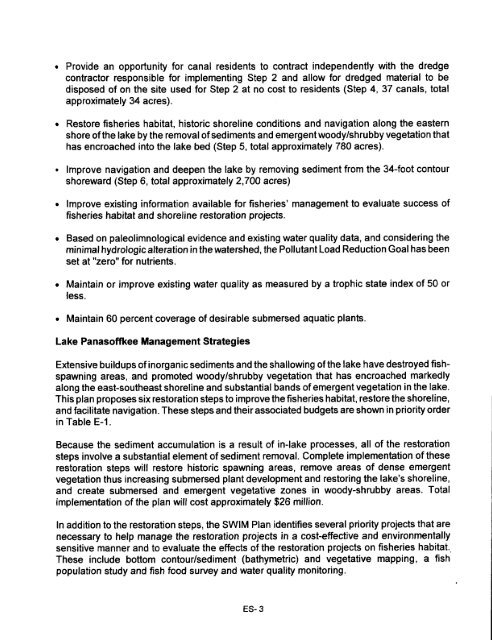Lake Panasoffkee SWIM Plan - Southwest Florida Water ...
Lake Panasoffkee SWIM Plan - Southwest Florida Water ...
Lake Panasoffkee SWIM Plan - Southwest Florida Water ...
You also want an ePaper? Increase the reach of your titles
YUMPU automatically turns print PDFs into web optimized ePapers that Google loves.
Provide an opportunity for canal residents to contract independently with the dredge<br />
contractor responsible for implementing Step 2 and allow for dredged material to be<br />
disposed of on the site used for Step 2 at no cost to residents (Step 4, 37 canals, total<br />
approximately 34 acres).<br />
Restore fisheries habitat, historic shoreline conditions and navigation along the eastern<br />
shore of the lake by the removal of sediments and emergent woody/shrubby vegetation that<br />
has encroached into the lake bed (Step 5, total approximately 780 acres).<br />
. Improve navigation and deepen the lake by removing sediment from the 34-foot contour<br />
shoreward (Step 6, total approximately 2,700 acres)<br />
Improve existing information available for fisheries' management to evaluate success of<br />
fisheries habitat and shoreline restoration projects.<br />
Based on paleolimnological evidence and existing water quality data, and considering the<br />
minimal hydrologic alteration in the watershed, the Pollutant Load Reduction Goal has been<br />
set at "zero" for nutrients.<br />
Maintain or improve existing water quality as measured by a trophic state index of 50 or<br />
less.<br />
Maintain 60 percent coverage of desirable submersed aquatic plants.<br />
<strong>Lake</strong> PanasofFkee Management Strategies<br />
Extensive buildups of inorganic sediments and the shallowing of the lake have destroyed fishspawning<br />
areas, and promoted woody/shrubby vegetation that has encroached markedly<br />
along the east-southeast shoreline and substantial bands of emergent vegetation in the lake.<br />
This plan proposes six restoration steps to improve the fisheries habitat, restore the shoreline,<br />
and facilitate navigation. These steps and their associated budgets are shown in priority order<br />
in Table E-1.<br />
Because the sediment accumulation is a result of in-lake processes, all of the restoration<br />
steps involve a substantial element of sediment removal. Complete implementation of these<br />
restoration steps will restore historic spawning areas, remove areas of dense emergent<br />
vegetation thus increasing submersed plant development and restoring the lake's shoreline,<br />
and create submersed and emergent vegetative zones in woody-shrubby areas. Total<br />
implementation of the plan will cost approximately $26 million.<br />
In addition to the restoration steps, the <strong>SWIM</strong> <strong>Plan</strong> identifies several priority projects that are<br />
necessary to help manage the restoration projects in a cost-effective and environmentally<br />
sensitive manner and to evaluate the effects of the restoration projects on fisheries habitat..<br />
These include bottom contour/sediment (bathymetric) and vegetative mapping, a fish<br />
population study and fish food survey and water quality monitoring.<br />
ES- 3
















